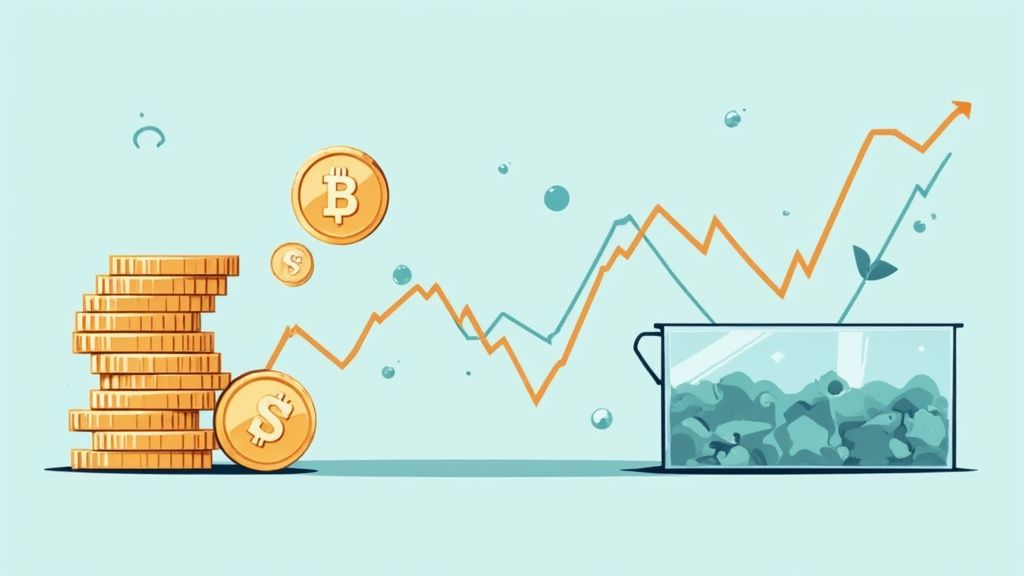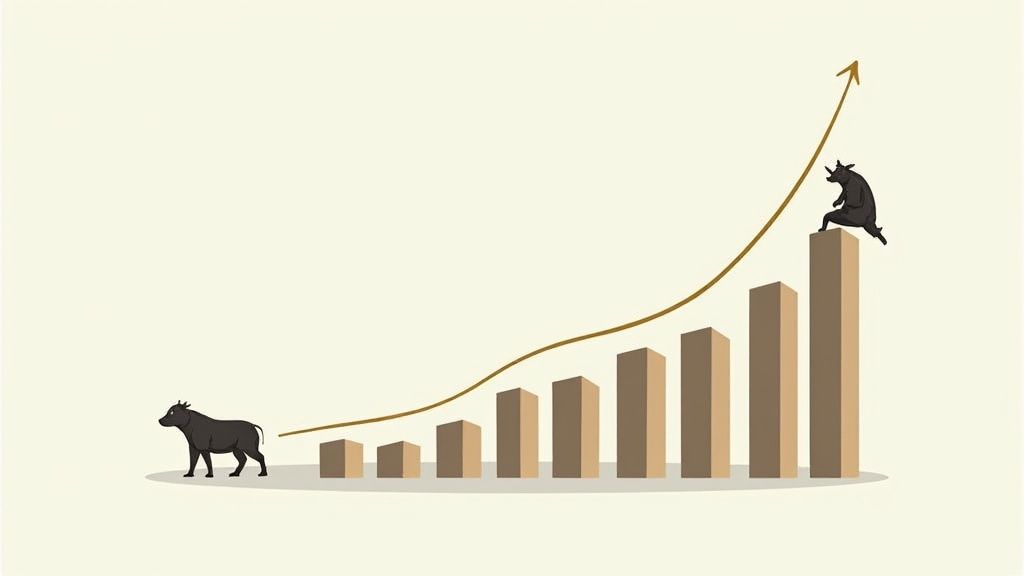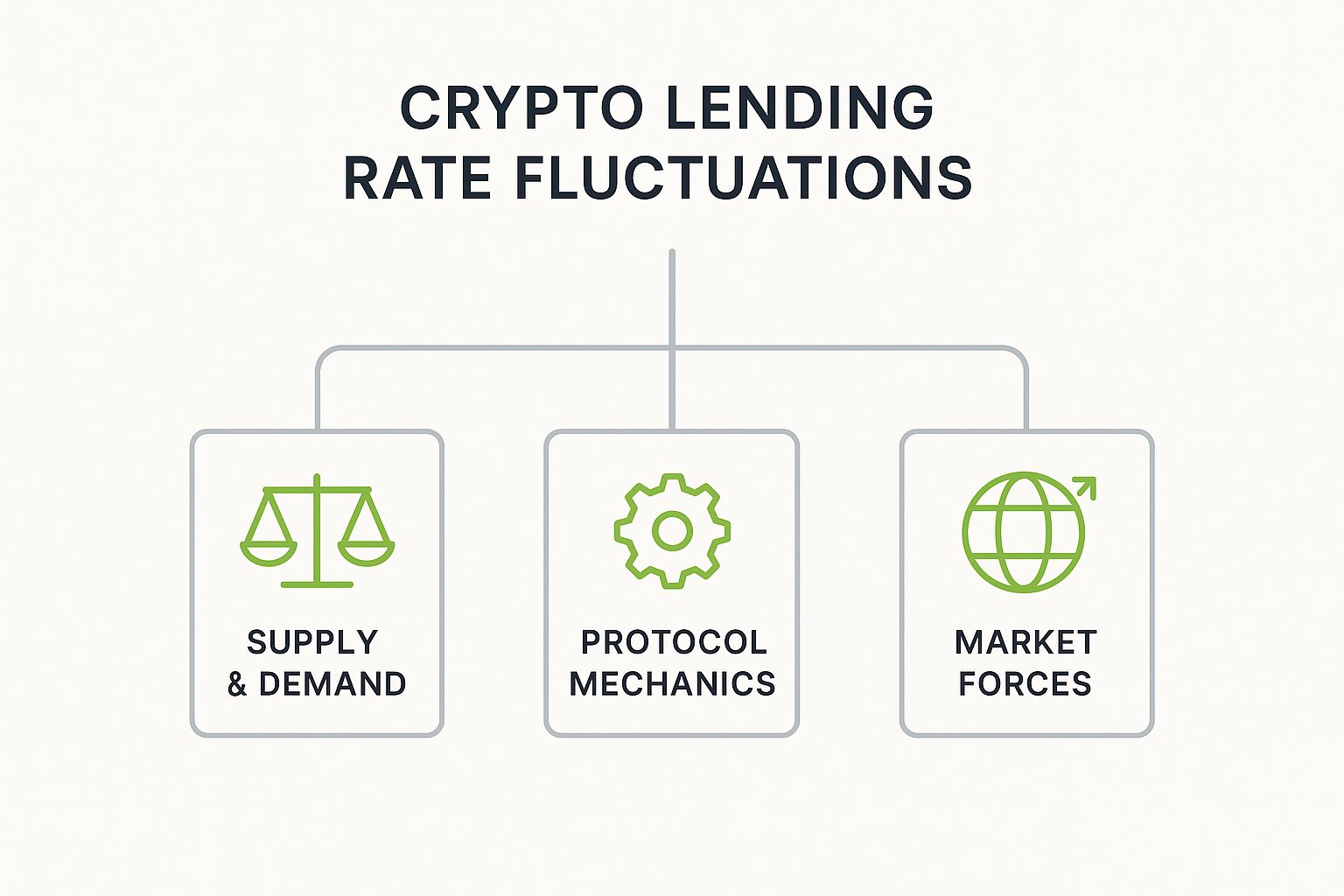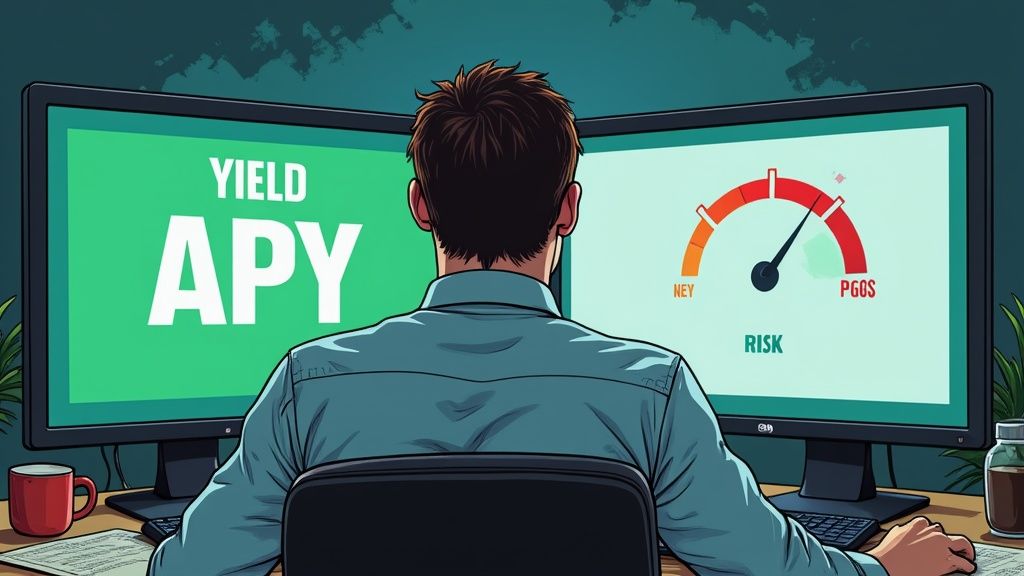Understanding Crypto Lending Rates: A Guide for Allocators
Learn everything about crypto lending rates, including market factors, risk considerations, and tips for maximizing DeFi and CeFi yields.
Oct 18, 2025
generated
Crypto lending rates represent the interest earned by lenders or paid by borrowers on digital asset loans. They are fundamentally different from yields in traditional finance, driven by the crypto market's inherent volatility and a significant appetite for leverage.
Think of it as surge pricing for capital in a market that never sleeps. These rates are not set by a central bank committee; they are determined by raw, real-time supply and demand dynamics on a global scale, often executed algorithmically by smart contracts.
What Drives Crypto Lending Rates?

For allocators accustomed to traditional credit markets, the world of crypto lending can feel unfamiliar. Rates for borrowing Bitcoin or stablecoins can swing dramatically, offering yields that make conventional banking products appear static. The key question for retail and institutional investors alike is: why are these rates so high and so volatile?
Unlike benchmark rates set by monetary authorities, crypto lending rates are a direct, on-chain reflection of market activity. They are determined algorithmically by smart contracts, instantly reacting to the tension between lenders supplying capital and borrowers demanding it. This creates a market that is highly responsive and transparent, yet also famously unpredictable.
The Core Forces at Play
To analyze this market effectively, it's essential to understand the foundational pillars that determine the price of capital in the digital asset economy. Mastering this framework is the first step toward building a strategic advantage.
The main drivers include:
Supply and Demand: This is the bedrock. When more participants want to borrow an asset than lend it, rates increase. When there is a surplus of lendable capital, rates compress.
Protocol Mechanics: Decentralized lending platforms are governed by automated smart contracts, not management teams. These protocols have built-in rules that adjust rates based on the utilization rate—the percentage of total available funds currently being borrowed. High utilization triggers higher rates to incentivize new supply and temper demand.
Market Sentiment: During bull markets, demand for leverage to gain long exposure intensifies, driving borrowing rates higher. In bear markets, this demand evaporates, and rates often decline significantly.
The core principle is that crypto lending operates as a free-flowing capital market. The availability of assets and the appetite for risk create a dynamic pricing environment where the cost of borrowing is constantly being discovered.
This mechanism is crucial for investors to understand. It shows how factors like liquidity in cryptocurrency have a direct and often immediate impact on yield opportunities. For any allocator conducting due diligence, breaking down these components provides a clear model for evaluating the sustainability—and the risk—behind the yields in the crypto credit space.
The Market's Journey: From Boom to a New Baseline

To understand today's crypto lending rates, one must review the market's recent history. This sector was forged in a series of dramatic boom-and-bust cycles that shaped its current structure. For allocators, this history provides crucial context for understanding yield sources and the resilience of the underlying systems.
A powerful metric for tracking this journey is Total Value Locked (TVL), which represents the total capital users have deposited into lending protocols. It serves as a barometer for market confidence. Rising TVL indicates that trust and capital are flowing in; a decline signals that investors are becoming risk-averse and withdrawing assets.
The DeFi Boom and Its First Stress Test
The story of modern crypto lending begins with the rise of decentralized finance (DeFi). Before 2020, on-chain lending was a niche experiment. What followed was a period of explosive growth.
Capital flowed into protocols promising high yields. DeFi lending TVL, which was near zero in early 2020, skyrocketed to $15 billion by January 2021 and peaked at nearly $45 billion in January 2022. This demonstrated a massive appetite for on-chain credit.
Then came the correction. By mid-2022, TVL had fallen back to $15 billion, erasing billions in value and highlighting the sector's volatility. For a detailed view of this period, refer to historical crypto lending and borrowing statistics.
This cycle of hyper-growth followed by a severe contraction was the market's first major stress test. The protocols that endured were those with more sophisticated risk management, transparent operations, and a user base not solely driven by speculative yields.
Establishing a More Mature Foundation
Though painful, the downturns served a vital purpose: they exposed unsustainable models and triggered a "flight to quality." Surviving platforms proved their resilience, and a more discerning market began to emerge. Investors started looking beyond headline yields to focus on protocol security and on-chain transparency.
This structural shift is visible in the market’s recovery. Capital returned, but this time it was allocated more selectively, seeking sustainable returns from established, battle-tested protocols. As of June 2025, the TVL in DeFi lending has not just recovered; it has settled at a robust $48 billion, establishing a new, higher baseline of activity.
This history shows a market that has been tested and emerged with a stronger, more transparent foundation—a critical data point for any allocator performing due diligence today.
Deconstructing the Engine of Rate Fluctuations
Crypto lending rates are a live, direct reflection of on-chain market dynamics. To understand why a stablecoin might yield 1% one month and 10% the next, one must analyze the core mechanics. Three main forces work in concert to set the price of capital in the digital asset ecosystem.
Imagine a lending pool as a hotel. When only a few rooms are booked (low borrowing), the manager might lower prices to attract guests. As occupancy approaches 100%, the price for the last few available rooms skyrockets. This analogy captures the essence of how crypto lending rates function.
Supply and Demand Dynamics
At its core, the crypto credit market is a pure expression of supply and demand.
On one side is the "supply"—lenders, including individuals, funds, and institutions, who deposit assets like BTC or USDC into a lending pool to earn a yield. On the other side is "demand"—borrowers who require capital to leverage a trade, fund operations, or avoid selling assets at an inopportune time.
When borrower demand outstrips the available supply in the pool, rates climb. Conversely, when the pool is over-supplied and borrowing is slow, rates drop to attract new borrowers. This constant push-and-pull creates a pricing environment that can shift by the minute.
Protocol Mechanics and Utilization Rates
In decentralized finance (DeFi), these forces are managed by automated code, not people. Lending protocols use algorithms that instantly adjust interest rates based on a critical metric: the utilization rate. This is the percentage of total supplied capital that is currently being borrowed.
Low Utilization (e.g., below 75%): Interest rates rise gradually and predictably as more capital is borrowed. This is designed to encourage more lending by offering a steady return.
High Utilization (e.g., above 90%): The interest rate curve steepens dramatically, often resembling a hockey stick. This sharp price increase is a defense mechanism; it aggressively disincentivizes further borrowing and signals for new lenders to supply liquidity, ensuring funds remain available for withdrawals.
This algorithmic approach allows the protocol to manage its own health autonomously, creating a transparent but highly reactive system.
Broader Market Forces and Sentiment
Finally, the wider market context cannot be ignored. Crypto lending rates are heavily influenced by broader market conditions. These external factors can alter the supply-and-demand balance almost overnight, causing significant rate swings.
The crypto credit market often acts as a barometer for overall market sentiment. A surge in stablecoin borrowing rates, for example, frequently indicates a bullish outlook as traders seek leverage to buy more volatile assets.
To provide a clearer picture of how these components interact, the following table summarizes the primary drivers to monitor.
Primary Drivers of Crypto Lending Rates
Factor | Description | Impact on Rates | Key Metrics to Watch |
|---|---|---|---|
Supply & Demand | The core balance between assets available to be lent and the capital being actively borrowed. | Direct: More demand than supply = higher rates. More supply than demand = lower rates. | Pool size, borrow volume, and utilization rate. |
Protocol Mechanics | Algorithmic rules that automatically adjust rates based on the utilization of a lending pool. | Systematic: Rates follow a pre-defined curve, rising sharply at high utilization levels. | The protocol's interest rate model and utilization thresholds. |
Market Sentiment | The overall mood of the crypto market, from extreme bullishness to fear and bearishness. | Volatile: Bull markets spike leverage demand, raising rates. Bear markets crush demand, lowering them. | Volatility indices, trading volumes, and social sentiment data. |
Arbitrage & External Yields | Opportunities for traders to profit from rate differences between platforms or asset types. | Balancing: Capital moves to chase the highest yield, which can quickly drain or fill pools. | Staking rewards, yield farm APYs, and rates on other lending platforms. |
The key takeaway is that rates are not random; they are a direct signal from the market. Key forces to monitor include:
Bull vs. Bear Cycles: In bull markets, demand for leverage is high, sending borrowing rates upward. During bear markets, that demand diminishes, and rates often collapse.
Arbitrage Opportunities: If a trader can borrow USDC at 5% on one platform and earn 8% staking it elsewhere, they likely will. These arbitrage activities cause large capital shifts, impacting supply. For a deeper look at how rates work in different market segments, our guide on crypto funding rates offers valuable context.
Macroeconomic Events: While the crypto ecosystem often operates independently, major economic shifts can still impact risk appetite and capital flows.
For any allocator, understanding these three pillars—supply and demand, protocol rules, and market forces—is essential for conducting proper due diligence and interpreting the signals behind fluctuating crypto lending rates.
When evaluating crypto lending, one must distinguish between two parallel universes: Centralized Finance (CeFi) and Decentralized Finance (DeFi). Both can generate yield, but their operational structures—and more importantly, their risk profiles—are worlds apart. For any allocator analyzing crypto lending rates, understanding this distinction is a critical first step.
In CeFi, you entrust your assets to a company, similar to a traditional bank. A management team sets rates, and the primary concern is counterparty risk—the risk that the platform becomes insolvent. The model's success hinges on prudent financial management and robust operational security.
DeFi completely inverts this model. Instead of a company, your counterparty is a smart contract—a piece of code deployed on a blockchain. This fundamentally changes the risk landscape.
The Shift to On-Chain Transparency
With DeFi, lending rates are not decided by a committee. They are determined by open-source algorithms that anyone can audit. This verifiable, on-chain activity is a significant advantage for investors who value transparency. However, risk does not disappear; it changes form. The focus shifts from a corporate balance sheet to the integrity of the code itself.
Here, the primary concern becomes smart contract risk—the potential for a bug or exploit that could drain a lending pool. We break this down in more detail in our guide on how DeFi lending works.
This infographic illustrates the core drivers of crypto lending rates across both CeFi and DeFi.

As shown, the fundamental drivers are consistent: supply, demand, protocol rules, and broader market dynamics.
DeFi's Growing Market Dominance
Market data indicates a clear preference for on-chain systems. Following a severe crypto winter, DeFi not only survived but emerged as the dominant force in the lending space.
The total crypto lending market saw open borrowings peak at $48.4 billion in Q4 2021 before a market-wide crash reduced this figure by 80% to just $9.6 billion by Q4 2022. As the market recovered to $30.2 billion by Q4 2024, DeFi's share of that total had grown dramatically.
During the 2020-2021 bull run, DeFi accounted for only 34% of borrows. By late 2024, DeFi protocols commanded nearly 63% of the entire market.
This is not merely a cyclical trend; it is a structural shift. It suggests that market participants are increasingly choosing the verifiable, transparent nature of DeFi protocols, despite the associated technical complexity.
Of course, a proper comparison of CeFi and DeFi must also consider the underlying data infrastructure. The reliability of on-chain data is paramount for accurate risk assessment. This challenge is being addressed by new solutions providing data integration for DeFi-focused blockchains like Injective.
For allocators, the choice involves a fundamental trade-off: the operational simplicity of a centralized entity versus the transparent but technically demanding risk framework of a decentralized protocol.
A Practical Framework for Evaluating Yield

High crypto lending rates are designed to capture attention. For serious allocators, however, the headline APY is merely the starting point of the analysis.
The essential work involves determining whether that yield is sustainable or a warning sign of unacceptable risk. To move beyond surface-level numbers and make informed capital allocation decisions, a structured evaluation framework is necessary.
This process involves looking past the advertised rate to scrutinize the engine generating the yield. Is it powered by genuine borrowing demand, or is it propped up by temporary token incentives? Answering this question is the first step in distinguishing a durable opportunity from a high-risk gamble.
Deconstructing the Source of Yield
Before allocating capital, one must understand exactly where the returns originate. The source of yield is the single most important factor in assessing its quality and durability. Not all yield is created equal, and its origin story is key to understanding its risks.
A healthy, organic yield typically comes from one of two sources:
Borrowing Demand: This is the traditional model where lenders earn interest directly from borrowers who are paying for the use of capital. High rates here can be a positive signal, suggesting strong, organic demand for the asset.
Protocol Revenue: Some platforms share revenue streams, distributing a portion of their trading fees or liquidation revenue back to liquidity providers. This model aligns the interests of lenders with the overall success of the protocol.
The core objective is to distinguish between organic yield generated by real economic activity and synthetic yield created by incentive programs. The former is a sign of a healthy market; the latter often masks a fundamental weakness.
Red Flags and Risk-Adjusted Returns
Overly aggressive incentive programs are one of the biggest red flags. When a platform offers a high APY paid out in its own native token, it can create a dangerous feedback loop.
New capital rushes in to capture the yield, which boosts the token's price, making the APY appear even more attractive. This cycle is inherently unstable and can collapse quickly, leaving late participants with a devalued token.
This highlights the crucial difference between raw yield and risk-adjusted returns. A 15% APY from a battle-tested protocol with deep liquidity is fundamentally different from a 50% APY on a new, unaudited platform. The higher rate is not "better" if it comes with an exponentially greater risk of total loss due to a smart contract bug or a flawed economic model.
Effective due diligence means asking critical questions:
Smart Contract Risk: Has the protocol undergone multiple, independent security audits? What is its operational track record?
Economic Model Risk: Is the yield entirely dependent on unsustainable token emissions? How would the return be affected if the native token price collapses?
Counterparty Risk: If using a centralized platform, what is the financial health and regulatory standing of the company?
Platforms that aggregate data from multiple sources are invaluable here. By comparing the crypto lending rates of a specific opportunity against the market average, allocators can better assess the associated risk. This comparative data provides a clear, repeatable methodology for evaluating any yield opportunity.
Why Crypto Rates March to Their Own Beat
For allocators schooled in traditional markets, one of the most puzzling aspects of crypto lending is its apparent disconnect from global monetary policy. When the Federal Reserve or the ECB adjusts policy, the ripple effects are felt across asset classes, from mortgages to corporate bonds.
Yet, crypto lending rates often appear indifferent. They move to their own rhythm, seemingly decoupled from the primary forces shaping global finance.
This is not a flaw; it is a feature of a largely self-contained ecosystem. The crypto credit market is fueled not by macroeconomic policy but by crypto-native dynamics. Factors like the demand for on-chain leverage, the speculative sentiment of a bull run, or a new yield farming strategy have a much greater impact on rates than a central bank announcement.
A Separate Financial System
It is useful to think of crypto as a parallel financial system operating on different rails. The drivers are unique, the participants are different, and the infrastructure is built from a distinct blueprint.
This is supported by academic research. A 2024 study highlighted that DeFi interest rates are highly volatile and show no significant correlation to traditional benchmarks. The study found that protocol incentives, liquidation risks, and internal market sentiment are the primary drivers, making these rates resilient to traditional monetary policy shifts. You can explore the findings from the Banque de France on DeFi's unique interest rate behavior.
Understanding this disconnect is critical for portfolio construction. It explains both the potential for diversification and the unique risks inherent in a market with its own set of rules.
While a rate hike from a central bank might cool the housing market, it may have no immediate impact on the cost to borrow a stablecoin.
For an allocator, this is a double-edged sword. On one hand, it offers a source of yield that may not be correlated with a traditional fixed-income portfolio—a powerful diversifier. On the other, it introduces a new set of risks that cannot be analyzed with conventional playbooks.
The key is to recognize that one is not just adding a new asset, but stepping into an entirely different financial system.
Key Questions on Crypto Lending Rates
As investors explore the world of crypto lending, several common questions arise. Addressing them directly can help clarify the concepts discussed.
Are higher crypto lending rates always better?
Not necessarily. While a high APY is attractive, it often corresponds with heightened risk. An unusually high rate may signal that the yield is artificially inflated with unsustainable token rewards or that a protocol is taking on excessive risk. In a worst-case scenario, it could mask a critical smart contract vulnerability.
Prudent allocators focus on the risk-adjusted return. It is essential to investigate the source of the yield and the health of the underlying protocol before committing capital.
What drives stablecoin lending rates?
Stablecoin rates are primarily driven by the market's appetite for leverage. During bull markets, traders seek to borrow stablecoins like USDC to increase their exposure to other crypto assets. This surge in demand pushes lending rates up.
The equation also includes supply-side factors. The total supply of stablecoins available from lenders, combined with a protocol's specific utilization rate, also plays a crucial role in determining the final interest rate.
What are the main risks in CeFi vs. DeFi lending?
The risk profiles of CeFi and DeFi are distinct. In Centralized Finance (CeFi), the primary concern is counterparty risk—the potential for the platform to fail. In Decentralized Finance (DeFi), the risks are technical: smart contract risk (the potential for bugs or exploits in the code) and liquidation risk (the risk of collateral value dropping too quickly).
Gain a decisive edge in the digital asset market with Fensory. Our institutional-grade terminal consolidates the entire landscape of BTC and stablecoin investment products, providing the data-driven insights needed for superior due diligence and capital allocation. Discover curated investment opportunities at fensory.com.